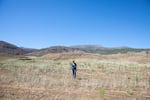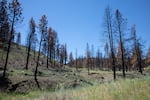
Three major wildfires have torched the hillside above Withers Ranch near Paisley, Ore., in the past 20 years.
Bradley W. Parks / OPB
Withers Ranch sits a few miles north of Paisley, Oregon, at the base of what’s called the Winter Ridge. It’s where the land plunges downward thousands of feet to form the stiff western edge of the Chewaucan-Summer Lake Basin.
On the hillside above the ranch is a lone patch of green that resource managers in Lake County are trying to protect — because they know it’s ready to burn.
“You can see this would just light up like a tinderbox,” said Autumn Muir. She’s the uplands coordinator for the Lake County Umbrella Watershed Council and toured the ridge with OPB in late June.
The green smear of trees at Withers Ranch is surrounded by the remnants of three major fires that ripped through this part of Southern Oregon in the past 20 years — the Toolbox Complex of 2002, the Watson Creek Fire of 2018 and last year’s Brattain Fire. Tree skeletons in various stages of decay serve as grim reminders of blazes past, but it’s the stubby plants growing between them that foreshadow the danger of future fires.
Invasive weeds like cheatgrass are fueling larger, hotter fires on Oregon rangelands — and money to fight those weeds dried up at the onset of the COVID-19 pandemic.
Muir plucked a flaxen stem from the ground and held it up to the light. It was the hottest day of the year in the middle of what could be the worst drought in Oregon’s recorded history.
“This cheatgrass is all dried out already,” she said. “It’s all ready to go.”

A healthy head of ryegrass (left) stays greener much longer than invasive cheatgrass (right).
Bradley W. Parks / OPB
Cheatgrass is a short, spindly plant that flops over from the weight of the seed head — and it’s everywhere in Oregon.
Cheatgrass and other invasive plants have elbowed their way into the nooks and crannies of overgrazed rangelands across the American West. They dry out quicker than native shrubs and bunchgrasses, creating the equivalent of tissue paper in a wildfire.
“[The landscape] just has this continuous carpet of fuel that keeps the fire going, burns it more intensely, and then when it hits the forest or timberland, it’s so thick in there it just gets really out of control,” Muir said.
OPB’s tour with Muir was weeks before the Bootleg Fire started in Klamath County to the west. The blaze has since chewed through bone-dry forestland on its way toward the Winter Ridge, threatening to fulfill resource managers’ predictions.
“The fire is going to continue to grow,” said Bootleg incident commander Joel Hessel in a fire update July 15. “The extremely dry vegetation and weather are not in our favor.”
Local watershed councils like Muir’s play a key role in preparing Oregon landscapes for wildfire — and recovering from previous ones — by treating noxious weeds like cheatgrass and restoring native vegetation. But here in Lake County, as well as in others across the state, a lot of that work has been on hold the past year.

Autumn Muir wades through a patch of grasses seeded to stabilize soils, provide forage and compete with invasive species at Withers Ranch after the Brattain Fire of 2018.
Bradley W. Parks / OPB
Oregon Lottery dollars help to fund weed management and watershed enhancement projects by way of grants to local watershed councils, administered by the Oregon Watershed Enhancement Board or OWEB.
When the COVID-19 pandemic forced the closure of Oregon bars and restaurants last spring, lottery revenue tanked.
That’s because nearly three-quarters of Oregon Lottery revenue is from video terminals, many of which are situated inside the bars and restaurants people couldn’t access. Lottery operating revenues declined more than $200 million in fiscal year 2020, and nearly $170 million of that was attributed to lost video lottery sales.
The Oregon Lottery had to cut somewhere, and funds for OWEB grants were on the chopping block.
“We really had to scramble,” said Meta Loftsgaarden, OWEB’s executive director. “We knew a month or so ahead of time, as we watched those bars and restaurants close, that we were going to be in a pretty dire situation come May and June.”
The lost funding, in addition to pandemic restrictions that moved a lot of work online, brought many landscape restoration projects — not just weed treatment — to a standstill.
The agency used what money it had on-hand to fulfill some grant applications, but paused funding additional projects until March.
Lottery revenue has since rebounded, and OWEB is fully funding grants again. The delay amounted to six months on the calendar, but for some projects the setback could be even longer.

Autumn Muir outside Paisley, Ore., Monday, June 28, 2021.
Bradley W. Parks / OPB
Muir said combating an invasive weed like cheatgrass is a momentum game. The plant waits for no pandemic.
“You’re getting down from these larger patches to these smaller patches, down to like maybe even a single plant source,” Muir said. “And you miss a year of that, and you can imagine you’d just lose all that momentum.”
Cheatgrass spreads easily and can produce some 500 seeds per plant. It greens up earlier in the year, outcompeting native plants for nutrients and water. When it dries out, it becomes functionally inedible for cattle and wildlife, and stands ready to burn.
And when cheatgrass burns, the fire can gobble up anything else in its path — including perennial grasses, shrubs and forbs as well as larger trees.
After fire, guess who comes back first: cheatgrass. As NPR put it, “more fire means more cheatgrass, and more cheatgrass means more fire.” The prolific weed eventually edges out perennials like sagebrush to the point where they no longer exist on the landscape.
The combination of invasive species and fire pose perhaps the largest threat to a shrinking sagebrush ecosystem in the American West.
“If all this burned that we’re looking at right now, it would not come back for like 50 years under the best of situations,” Muir said.
“Now you add in drought. Now you add in maybe that the people that would do the restoration can’t meet or can’t get the funding. And you add in your invasive annuals. And it’s gone — forever. Forever, it’s gone. It’s an irreplaceable commodity.”
Despite the lost lottery dollars, the Lake County Umbrella Watershed Council was able to secure $75,000 of emergency funding from the Oregon Legislature after last year’s Brattain Fire. The council leveraged that grant to pull in additional funding up to $500,000, which allowed it to seed close to 5,000 acres of the more than 50,000 that burned.

Blackened trees stand in the Brattain Fire scar near Paisley, Ore. Many forbs have regrown naturally here, and resource managers seeded riparian zones with grasses.
Bradley W. Parks / OPB
That included some land near Withers Ranch, where the plump, green heads of recently planted grasses bobbed and swayed in the wind. Those plants will help stabilize soils, compete with fire-prone invasives like cheatgrass and provide forage.
Still, Muir said, she and her colleagues still worry about the next fire, and the Bootleg Fire is increasingly looking like it could be the one.
“All the things that would slow or make a fire become more mosaic and natural aren’t there,” Muir said. “We can get it back to that, but it takes time, collaboration, partnership and money.”
